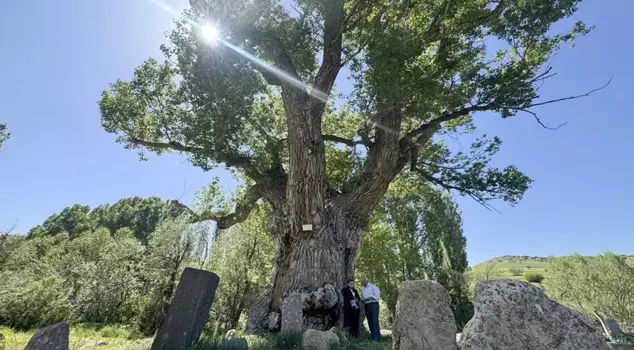
25.05.2025 18:10
A cemetery located in the Develi district of Kayseri hosts not only the tombstones of Turkish tribes but also the ornate gravestones from the Ottoman period. The cemetery contains stamped gravestones belonging to five Turkish tribes: Kargın, Bayındır, Eymir, Salur, and Alkaevli. Associate Professor Dr. Aslı Sağıroğlu stated, "I have not come across a gravestone within a monumental tree; there is no example of it. Perhaps there are no such examples even in the world."
```html
In the Çataloluk neighborhood, located 43 kilometers from the Develi district of Kayseri, the cemetery next to the Ikizler Stream, a tributary of the Zamantı River, hosts not only the graves of Turkish tribes but also ornate gravestones from the Ottoman period.
HOSTING 5 TURKISH TRIBES
The cemetery, where the deceased residents are still buried, draws attention with its stamped gravestones belonging to 5 Turkish tribes: Kargın, Bayındır, Eymir, Salur, and Alkaevli. Associate Professor Dr. Aslı Sağıroğlu, a faculty member of the Department of Art History at Erciyes University, who has researched the cemetery and published articles, stated that Turks have maintained their burial customs since Central Asia, and that gravestones serve as a deed of ownership.
GRAVESTONES INSIDE A 750-YEAR-OLD MONUMENTAL TREE
Sağıroğlu, who learned about the historical cemetery through cultural and historical researcher Nezir Ötegen and encountered a very interesting scene when he arrived in the region, said, "Two gravestones greeted me inside the monumental tree. One of the gravestones had a stamp on it. As a result of our research, we learned that it belonged to a Turkish tribe. The monumental tree is approximately 750 years old and is a registered black locust. Based on this registration, we concluded that the gravestones were erected before this monumental tree."
"THERE IS NO SUCH EXAMPLE EVEN IN THE WORLD"
Sağıroğlu noted that the nomadic Turkmen tribes wishing to pass from Cilicia to Cappadocia used the Çataloğlu neighborhood as a base, and that they understood their presence from the gravestones. He stated that Turkish tribes engraved their own stamps on the graves, saying, "We can also see these stamps on carpets, felts, and rugs. We identified two gravestones belonging to the Alkaevli and Eymir tribes. The gravestone inside the monumental tree belongs to the Kargın tribe. There are mostly gravestones belonging to the Salur tribe. I have not encountered a gravestone inside a monumental tree in Turkey; there is no example of it. Perhaps there is no such example even in the world." he said.
"AFTER AHLAT, WE CAN SAY THIS IS AN IMPORTANT CEMETERY AREA IN ANATOLIA"
Sağıroğlu recalled that the most important example of the gravestones of the first Turkish tribes was found in Ahlat and continued: "Ahlat is very distinct, especially with its decorations, menhir (large stone blocks placed vertically in the ground), and the tradition of upright stones. After Ahlat, we can say this is an important cemetery area in Anatolia because it is significant not only for its stamped gravestones but also for its upright gravestones and menhir tradition. Additionally, we encounter ornate gravestones from the late Ottoman period after the period of Turkmen principalities, which express themselves with very special images."
CLEANED 437 GRAVESTONES OVER 68 DAYS WITH HIS STUDENTS
Sağıroğlu, drawing attention to the ongoing burial process in the cemetery, stated that this would lead to the gradual destruction of the cemetery, and therefore new burials should be halted. He added that in 2021, with the support of the Develi Municipality, they conducted a series of studies in the cemetery area with undergraduate, doctoral, and master's students for 68 days, cleaning the lichens from 437 gravestones, performing mechanical cleaning, inventorying the stones, and writing articles.
```